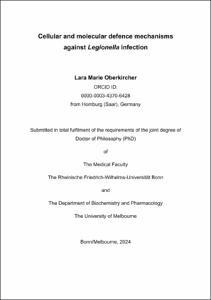Cellular and molecular defence mechanisms against Legionella infection
Cellular and molecular defence mechanisms against Legionella infection
| dc.contributor.advisor | Garbi, Natalio Garcia | |
| dc.contributor.author | Oberkircher, Lara Marie | |
| dc.date.accessioned | 2024-01-26T11:32:51Z | |
| dc.date.issued | 26.01.2024 | |
| dc.identifier.uri | https://hdl.handle.net/20.500.11811/11273 | |
| dc.description.abstract | The two most prevalent causes of Legionnaires’ disease are L. pneumophila and L. longbeachae. The rising incidence of the Legionnaires’ disease over the past two decades together with the increasing prevalence of L. longbeachae in the Northern hemisphere highlights the necessity to gain a more detailed insight into the L. longbeachae-induced immune response. The aim of this thesis was to investigate the cellular and molecular mechanisms required for protection, focussing on immune cell responses and intracellular host-bacterial interactions. By combining a murine mouse model, a novel fluorescent reporter to track L. longbeachae, and cell depletion experiments, I uncovered the differential contribution of tissue-resident alveolar macrophages (AM) and infiltrating neutrophils to the defence against L. longbeachae. Early during infection, AM contained most of the bacteria. AM numbers sharply decreased during infection, which was accompanied by a large influx of neutrophils that also internalized bacteria. Comparative analysis of bacterial viability revealed that neutrophils were more efficient at killing and clearing of L. longbeachae than AM. In contrast, the results presented here indicated that lung-resident AM promoted infection, most likely by serving as a replicative niche. Defence against L. pneumophila is known to require IFN-gamma but not IL-18, a strong IFN-gamma inducer. However, Il18r1–/– mice were less able to clear L. longbeachae and had significantly impaired IFN-gamma levels in the lung. Furthermore, IL-18R signalling was critical for the efficient bacterial killing by neutrophils via production of reactive oxygen species. Previous bone marrow chimera experiments in our laboratory suggested that IL-18R expression in epithelial cells was necessary and sufficient for protection against L. longbeachae. However, genetic in vivo experiments using the Cre-lox-system revealed that IL-18R+ NK cells and T cells were central players in the IL-18-dependent anti-L. longbeachae defence via IFN-gamma secretion, whereas IL-18R expression by ciliated bronchiolar epithelial cells did not confer protection. Finally, our results highlighted key mechanisms by which Legionella subverts host macrophages to form an intracellular endoplasmic reticulum (ER)-like vacuole as its intracellular replicative niche. Establishment of the Legionella-containing vacuole (LCV) by recruitment of ER-derived vesicles induces ER stress. Although the relevance of ER stress in this process is unclear, effector proteins secreted by L. pneumophila are known to inhibit onset of the ER stress response. Using the pharmacological ER stress inducer thapsigargin, we showed that ER stress induces a protective host response promoting the secretion of pro-inflammatory cytokines, limiting intracellular L. pneumophila replication, and improving host survival. Mechanistically, ER stress induced a novel non-canonical activation of the transcription factor STAT1 via the IRE1 kinase driving transcription of the IFN-gamma-induced chemokine CXCL10. These results highlighted a potential role of the host ER stress response in the initiation of a protective cellular immune response towards L. pneumophila. | en |
| dc.language.iso | eng | |
| dc.rights | In Copyright | |
| dc.rights.uri | http://rightsstatements.org/vocab/InC/1.0/ | |
| dc.subject.ddc | 570 Biowissenschaften, Biologie | |
| dc.title | Cellular and molecular defence mechanisms against Legionella infection | |
| dc.type | Dissertation oder Habilitation | |
| dc.publisher.name | Universitäts- und Landesbibliothek Bonn | |
| dc.publisher.location | Bonn | |
| dc.rights.accessRights | embargoedAccess | |
| dc.date.embargoEndDate | 01.02.2026 | |
| dc.identifier.urn | https://nbn-resolving.org/urn:nbn:de:hbz:5-74292 | |
| ulbbn.pubtype | Erstveröffentlichung | |
| ulbbnediss.affiliation.name | Rheinische Friedrich-Wilhelms-Universität Bonn | |
| ulbbnediss.affiliation.location | Bonn | |
| ulbbnediss.affiliation.otherLocation1 | Melbourne | |
| ulbbnediss.affiliation.otherName1 | University of Melbourne | |
| ulbbnediss.thesis.level | Dissertation | |
| ulbbnediss.dissID | 7429 | |
| ulbbnediss.date.accepted | 19.01.2024 | |
| ulbbnediss.institute | Medizinische Fakultät / Institute : Institut für Experimentelle Immunologie (IEI) | |
| ulbbnediss.fakultaet | Medizinische Fakultät | |
| dc.contributor.coReferee | van Driel, Ian | |
| ulbbnediss.contributor.orcid | https://orcid.org/0000-0003-4370-6428 |
Dateien zu dieser Ressource

Dieses Dokument ist zur Zeit gesperrt.
Das Dokument erscheint in:
-
E-Dissertationen (2060)



